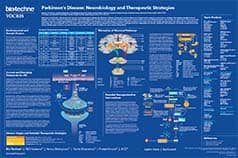Acetylcholine Nicotinic Receptors
Nicotinic receptors (nAChRs) are ligand-gated ion channels that modulate cell membrane potentials. Each receptor is composed of pentameric combinations of subunits (α1-10, β1-4, δ, ε and γ). Nicotinic receptors are generally divided into three functional classes: muscle subunits (α1, β1, δ, ε, γ), standard neuronal subunits (α1-6 and β2-4) that form in pairwise αβ combinations, and subunits (α7-9) that can form homomeric nAChRs. Neuronal nicotinic receptors are found in the central nervous system and in autonomic ganglia where they regulate processes such as transmitter release, cell excitability and neuronal integration. Nicotinic receptors located at the neuromuscular junctions of somatic muscles are responsible for muscular contraction.
Literature for Acetylcholine Nicotinic Receptors
Tocris offers the following scientific literature for Acetylcholine Nicotinic Receptors to showcase our products. We invite you to request* your copy today!
*Please note that Tocris will only send literature to established scientific business / institute addresses.
Parkinson's Disease Poster
Parkinson's disease (PD) causes chronic disability and is the second most common neurodegenerative condition. This poster outlines the neurobiology of the disease, as well as highlighting current therapeutic treatments for symptomatic PD, and emerging therapeutic strategies to delay PD onset and progression.
Nicotinic Receptor (nAChRs) Pharmacological Data
| Gene | Species | Gene Symbol | Gene Accession No. | Protein Accession No. |
|---|---|---|---|---|
| α1 (muscle) | Human | CHRNA1 | NM_000079 | P02708 |
| Mouse | Chrna1 | NM_007389 | P04756 | |
| Rat | Chrna1 | NM_024485 | P25108 | |
| α2 (neuronal) | Human | CHRNA2 | NM_000742 | Q15822 |
| Mouse | Chrna2 | NM_144803 | Q91X60 | |
| Rat | Chrna2 | NM_133420 | P12389 | |
| α3 | Human | CHRNA3 | NM_000743 | P32297 |
| Mouse | Chrna3 | NM_145129 | Q8R4G9 | |
| Rat | Chrna3 | NM_052805 | P04757 | |
| α4 | Human | CHRNA4 | NM_000744 | P43681 |
| Mouse | Chrna4 | NM_015730 | O70174 | |
| Rat | Chrna4 | NM_024354 | P09483 | |
| α5 | Human | CHRNA5 | NM_000745 | P30532 |
| Mouse | Chrna5 | NM_176844 | Q2MKA5 | |
| Rat | Chrna5 | NM_017078 | P20420 | |
| α6 | Human | CHRNA6 | NM_004198 | Q15825 |
| Mouse | Chrna6 | NM_021369 | Q9R0W9 | |
| Rat | Chrna6 | NM_057184 | P43143 | |
| α7 | Human | CHRNA7 | NM_000746 | P36544 |
| Mouse | Chrna7 | NM_007390 | P49582 | |
| Rat | Chrna7 | NM_012832 | Q05941 | |
| α9 | Human | CHRNA9 | NM_017581 | Q9UGM1 |
| Mouse | Chrna9 | NM_001081104 | NP_001074573 | |
| Rat | Chrna9 | NM_022930 | P43144 | |
| α10 | Human | CHRNA10 | NM_020402 | Q9GZZ6 |
| Mouse | Chrna10 | NM_001081424 | NP_001074893 | |
| Rat | Chrna10 | NM_022639 | Q9JLB5 | |
| β1 | Human | CHRNB1 | NM_000747 | P11230 |
| Mouse | Chrnb1 | NM_009601 | P09690 | |
| Rat | Chrnb1 | NM_012528 | P25109 | |
| β2 | Human | CHRNB2 | NM_000748 | P17787 |
| Mouse | Chrnb2 | NM_009602 | Q9ERK7 | |
| Rat | Chrnb2 | NM_019297 | P12390 | |
| β3 | Human | CHRNB3 | NM_000749 | Q05901 |
| Mouse | Chrnb3 | NM_173212 | Q8BMN3 | |
| Rat | Chrnb3 | NM_133597 | P12391 | |
| β4 | Human | CHRNB4 | NM_000750 | P30926 |
| Mouse | Chrnb4 | NM_148944 | Q8R493 | |
| Rat | Chrnb4 | NM_052806 | P12392 | |
| δ | Human | CHRND | NM_000751 | Q07001 |
| Mouse | Chrnd | NM_021600 | P02716 | |
| Rat | Chrnd | NM_019298 | P25110 | |
| ε | Human | CHRNE | NM_000080 | Q04844 |
| Mouse | Chrne | NM_009603 | P20782 | |
| Rat | Chrne | NM_017194 | P09660 | |
| γ | Human | CHRNG | NM_005199 | P07510 |
| Mouse | Chrng | NM_009604 | P04760 | |
| Rat | Chrng | NM_019145 | P18916 |
Nicotinic Pharmacological Receptor Data
| nACh Receptor Subtype | α2β4 | α7 | α3β4 | |
|---|---|---|---|---|
| Localisation | CNS - Cortex, thalamus, hippocampus,striatum | Autonomic ganglia, hippocampus, limbic system, cortex, chick retina | Autonomic ganglia, adrenal gland, hippocampus | |
| Tissue Function | Synaptic transmission, anti-nociception, anxiolytic, memory | Synaptic transmission, auditory gating, memory | Synaptic transmission | |
| Key Compounds | Ki (nM) | |||
| Agonists |
(±-)Anatoxin A (0789) (-)-Cytisine (1390) (±)-Epibatidine (0684) (-)-Lobeline (1077) RJR 2403 (1053) UB 165 (1348) |
1.3-4.2 0.14-2.7 0.01-0.05 4-50 26 0.27-0.44 |
707-1840 1400-3883 20.6-233 11000-13100 36000 2790 |
ND 56-195 0.38 480 ND ND |
| Antagonists |
Chlorisinamide (1001) Dihydro-β-erythroidine (2349) Methylcaconitine (1029) TMPH (2438) |
686000 370* 3700-6100 1400* |
ND ND 0.69-10.3 1000* |
ND 23100* ND 200* |
*IC50 values


